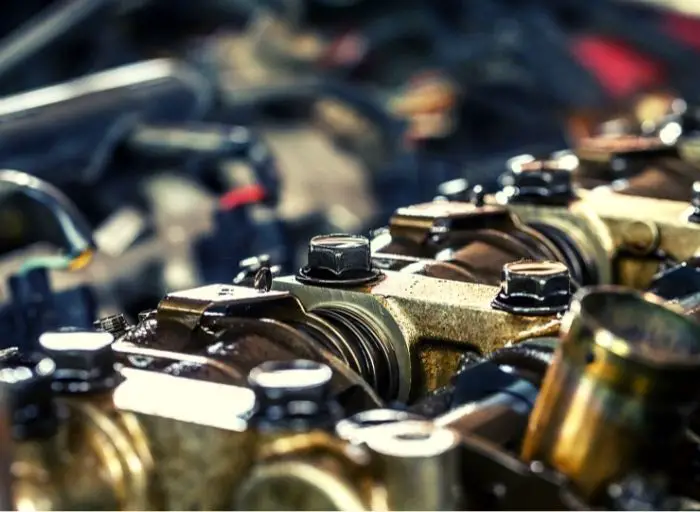
Modern engines require a steady, high-pressure fuel delivery when operating under load. It may be required to check the fuel pressure from time to time, but how to check fuel pressure without gauge?
Simply said, an OBD II diagnostic scanning tool is the best technique to assess fuel pressure without a gauge. The fuel pressure sensor will provide you with real-time engine fuel pressure measurements. Or, you can listen to the fuel pump buzz when you try to start your car.
Table of Contents
How to Check Fuel Pressure Without Gauge?
When detecting low fuel pressure, a fuel pressure gauge is required. A faulty pump supplying insufficient pressure can cause an engine to misfire, run lean, and hesitate when accelerating. What if you don’t have one and need to check your pressure?
Without a gauge, there are two ways to monitor fuel pressure. You can check fuel pressure with an OBD 2 scanner. If you don’t have a scanner, a buzzing sound can be heard when you try to start your automobile, indicating that the gasoline pump is putting pressure on the system.
Method 1: Using a diagnostic code reader.
If you don’t have a fuel pressure test kit, an OBD-II diagnostic code reader can be used to check the fuel pressure.
It only applies to newer vehicles equipped with fuel pressure sensors that constantly monitor the fuel pressure throughout the fuel injectors.
OBD 2 compatibility applies to vehicles that were manufactured after 1996. Also, pressure sensors can be seen with a diagnostic scan tool in some gas engine fuel injection systems.
Diagnostic Trouble Codes can assist you in determining whether the hard start is caused by low or excessive fuel pressure, albeit they cannot provide actual fuel pressure readings.
Instructions:
Step 1: Turn on the engine and let it idle for a few minutes.
You can also warm up your vehicle’s engine by driving it for 10 minutes. This will eliminate any issues with fuel pressure readings that are common in cold engines.
Step 2: Install the scanner to the OBD 2 port on your vehicle.
To locate the port, check your owner’s manual. It’s typically found beneath the steering wheel and above the pedals.
You can use the OBD 2 pin in your vehicle’s engine bay if you’re using a generic code reader or scanner.
Step 3: Retrieve OBD-II Error Codes that Have Been Saved
The diagnostic scanner will indicate one or more saved OBD-II trouble codes in the “P” series if there is a problem with gasoline delivery.
Here are some of the most prevalent OBD 2 problem codes:
- P0087: “Too Low Fuel Rail/System Pressure.” P0087 is a generic code that denotes a gasoline delivery system failure. When the ECM detects low fuel pressure at the fuel pressure sensor, it activates this feature. It’s comparable to P0088, which indicates that the fuel system has high fuel pressure.
- P018C: “Fuel pressure sensor “B” Circuit Low.” A faulty sensor and high or low fuel pressure can all result in this code.
- P0191: “Fuel Rail Pressure Sensor Circuit “A”. It shows that the fuel rail pressure readings may be irregular. Low or high fuel pressure are two mechanical and electrical concerns that might cause the P0191 code.
Step 4: Check the Fuel Pressure Data in Real-Time
If the error codes don’t suggest a problem with fuel pressure, you can use your scanner to watch real fuel pressure data. This feature is not available on all OBD 2 scanners. That is why you should check compatibility before purchasing.
Connect your diagnostic reader to the car and enter engine DME diagnostic mode to get a readout of current engine parameters if your reader supports real-time data. Select the gasoline delivery system option once the reading is complete.
This allows you to keep track of a variety of fuel system characteristics such as fuel rail pressure, fuel injection timing readings for each cylinder, short-term fuel trim, and long-term fuel trim.
The fuel rail pressure set point should also be visible on the OBD scanner. This is the ideal fuel pressure on the fuel rail when the engine is running, which you may compare to the real-time fuel pressure value.
Select the option from the selection that most nearly fits the ‘actual (real-time) fuel pressure parameter’ to measure the actual fuel pressure while the engine is running.
The current fuel pressure should now be displayed on the reader. Attempt revving the engine to 1500 rpm and holding it there for a few seconds to see whether it stays consistent under load, then try 2500-3000 rpm.
If the actual fuel pressure matches the fuel pressure set point, there is no problem with the general pressure in the system, but there may be an issue with the timing and amount of fuel delivered to the injectors.
Method 2: Testing for fuel pump buzz
So here’s the situation: you don’t have access to the gauge or diagnostic tools needed to monitor the pressure. What options do you have? You should still check to see if your gasoline pump is working properly. However, without a gauge or an OBD II scanner, there is still a means to monitor fuel pressure: fuel pump buzz.
Step 1: To turn on the gasoline pump, first turn the key from OFF to ON.
Step 2: As you turn the keys on, listen for a buzzing sound. If you notice a buzzing sound, your fuel pump is in good functioning order. That’s how you prime your fuel pump. The fuel pump pressurizes the gas in the pipes going to the injectors to maintain a strong fuel charge.
Step 3: If you don’t hear a buzzing sound, it’s a clue that your gasoline pump is malfunctioning. In the worst-case scenario, it could be a faulty relay switch, a blown fuse, a corroded or disconnected cable, or the gasoline pump itself.
Low Fuel Pump Pressure Symptoms
Low fuel pump pressure manifests itself in a variety of ways. Among them are:
Loss of engine power
The fuel pump cannot withstand the engine’s high demand if it is too weak. This is especially true in situations requiring a lot of power, such as abrupt acceleration or ascending a hill.
Starting out is difficult
The fuel pump must distribute the engine’s gas for the automobile to start correctly. When the fuel pump produces insufficient pressure, the gasoline cannot access the injectors for a complete combustion cycle. As a result, the engine REVs but never starts.
At high speeds, the engine pops
When traveling at high speeds or for lengthy periods of time, the engine sputters and then returns to normal. This occurs when the fuel pump fails to provide a steady stream of gasoline at the right pressure for an extended length of time.
What Is The Proper Engine Fuel Pressure?
Modern fuel injection gas engines operate at a fuel pressure of 40 to 70 PSI, depending on the engine type and size.
Fuel pressures at the injectors of common rail diesel engines can reach 2000 bar (29,000 PSI). A high-pressure fuel pump is frequently installed on diesel engines to boost the pressure of the fuel coming from the fuel tank pump. This aids in maintaining steady fuel pressure at the fuel rail.
Conclusion
Without a gauge, there are two methods to detect the fuel pressure in your vehicle. You can use a diagnostic code reader or an OBD II scanner to get real-time fuel pressure data. Likewise, your pump is fine if you hear buzzing when you turn the key on but don’t notice any other symptoms.
Hi there! I’m Naomi O’Colman. I’ve got years of experience working at an auto repair shop here in Texas under my belt. On top of that, ever since I was a kid I’ve been passionate about the auto industry. Since I’ve joined the team at automotivegearz.com I’ve been enthusiastically sharing my passion and insights with my readers. I’m dedicated to delivering high quality content and helping you stay up to date with the latest automotive trends and products out there!







